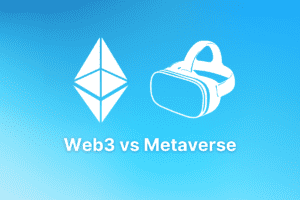What is Web3? Definition, Benefits, Challenges, & Use Cases
We’re reader-supported; we may earn a commission from links in this article.
Are you looking to stay ahead of the curve in today’s digital world? Web3 is here, and it promises a new level of data security, trustless transactions, and decentralization.
From automated smart contracts to improved scalability for blockchain applications – web3 offers a range of features that make it an attractive option for users who want more control over their online activities.
But what exactly is web3? How can we use this technology to our advantage? And how do we overcome any challenges associated with its implementation?
In this article, we’ll investigate the potential benefits of using web3 technology in comparison to conventional strategies such as web2 and look into any difficulties that may arise when attempting to implement it.
So keep reading if you’re ready to dive into the exciting world of decentralized technologies!
What is Web3?
Web3 is a decentralized, distributed platform that allows for peer-to-peer communication and transactions without relying on third parties or centralized authorities.
Web3 tech has enabled the emergence of novel applications, such as blockchain, smart contracts, and data storage solutions that run on its platform. Through the utilization of Web3 technology, individuals now have access to a plethora of new opportunities for online communication and commerce.
The definition of Web3 is based on three main components: decentralization, distribution, and autonomy. Decentralization implies that no singular entity is in charge of the network; instead, it’s shared by multiple users who can all be involved in its regulation through mechanisms like PoS or PoW.
Distribution refers to the way data is stored across many different nodes rather than one central server – this ensures that even if one node goes down, there are still copies available elsewhere on the network.
Autonomy describes how users have full control over their own data without having to rely on any third party for authentication or permission purposes.
The advantages of leveraging Web3 are manifold; its decentralized nature promotes efficiency and transparency while reducing associated costs related to infrastructure maintenance.
Furthermore, the network is accessible to all regardless of geographical location, with cryptographic algorithms employed by blockchain networks providing enhanced security and privacy protection as user data remains encrypted at rest within individual nodes on the network instead of being exposed externally via a centralized server system.
In conclusion, users can enjoy full autonomy over their data without having to depend on a third party for authorization or permission – granting them maximum control.
Given its potential to transform how we access and utilize data online, Web3 has been rapidly gaining traction. With its various use cases, it’s no wonder why Web3 is becoming increasingly popular.
How does web3 work?
Web3 is a system utilizing distributed ledger tech, cryptography, and smart contracts to create an open-source network allowing users to interact without third-party reliance.
Web3 works by using nodes which are computers connected together across a decentralized peer-to-peer network.
These nodes communicate with each other and store data in a shared public ledger known as the blockchain, where all transactions can be verified and tracked securely.
This allows for secure digital interactions between users while ensuring the trustworthiness and immutability of data stored on the blockchain.
Let’s now delve deeper into the various applications of Web3!
Key Takeaway: Web3 is the future of online communication and transactions, allowing users to have full autonomy over their data without relying on third parties. Web3 promises improved security, privacy, and efficiency through decentralization, distribution, and autonomy – a great option for those wanting to stay ahead in the digital era.
Use Cases for Web3
Web3 is a platform that enables developers to create distributed applications and services on the internet. It has many potential use cases, from data storage to smart contracts and automation.
DApps are among the most common use cases for Web3 technology, with these decentralized applications running on blockchain networks such as Ethereum enabling a variety of activities, from digital asset trading to providing financial services or gaming platforms.
DApps are distributed applications built on top of blockchain networks such as Ethereum or EOS. These applications can be used for anything from trading digital assets to providing financial services or even gaming platforms.
Smart contracts are another popular use case for Web3 technology. Smart contracts provide an automated system for two parties to make agreements without the need for a third-party, which can be more efficient than conventional legal deals.
This could potentially revolutionize business processes by eliminating paperwork and streamlining transactions while also increasing transparency and trust between parties involved in an agreement.
Data Storage is yet another essential use case for Web3 technology, thanks to its advanced security features that outshine traditional cloud storage solutions such as Amazon S3 or Google Cloud Platforms (GCP).
With blockchain-based data storage, all data is encrypted with a private key, ensuring only authorized users can access it and keeping sensitive information under lock and key.
Furthermore, since decentralized systems like those found in blockchains don’t have a single point of failure, businesses needn’t worry about losing their data if something goes awry with one server or node in the network.
Businesses can always recover it from other nodes across the network instead.
Overall, Web3 offers a variety of potential use cases ranging from DApps and smart contract automation to secure data storage solutions – each offering unique advantages over traditional methods when implemented correctly into existing business models or new projects alike.
Web3 provides a variety of use cases that are beneficial to both individuals and businesses.
With its increasing popularity, it is important to understand the advantages associated with using Web3 technology. Next, we will delve into the various advantages of Web3 technology.
Key Takeaway: Web3 is a revolutionary platform that offers businesses many opportunities to enhance their operations, such as distributed applications (DApps), smart contracts, and secure data storage. Web3 offers a paradigm shift in terms of how we interact with the digital world, delivering quicker transactions and higher assurance between parties.
Advantages of Using Web3
Web3 technology is revolutionizing the way we interact with digital data and applications. Web3 tech offers multiple benefits compared to classic web-based solutions, such as greater productivity, reduced expenditure, better access, and more secure privacy safeguards.
1. Increased Efficiency and Transparency
Web3 allows for faster transactions between users without having to go through third parties or intermediaries. This eliminates many steps in the process that can slow down operations.
Additionally, because all interactions are visible on the blockchain ledger, it increases transparency within organizations by providing an audit trail for each transaction.
2. Reduced Costs and Improved Accessibility
By eliminating middlemen from transactions, there are fewer fees associated with them which reduces costs for businesses as well as consumers.
Moreover, utilizing the network, regardless of one’s physical position, makes it simpler to perform global business operations at any moment without having to worry about exchange rates or other monetary issues commonly encountered with cross-border payments.
Overall, the advantages of using Web3 are numerous and can provide great benefits to users.
Despite the numerous advantages of Web3, certain obstacles must be overcome in order for it to gain widespread acceptance.
Challenges Faced with Implementing Web3
The implementation of Web3 technology is not without its challenges.
Despite its potential, the implementation of Web3 technology is hampered by technical complexity and a lack of knowledge among developers.
1. Lack of Expertise
Many developers don’t have the necessary experience or expertise to properly understand and utilize all the features available in Web3, making it difficult for them to create a successful product.
2. Lack of Proper Regulation
Additionally, regulatory uncertainty and compliance issues can make it hard for companies to use certain components of Web3 due to potential legal repercussions from governments or other organizations.
3. Lack of Scalability
Another challenge associated with implementing Web3 is limited scalability and interoperability.
4. Lack of Sufficient Transaction Speeds
Due to the decentralized nature of many Web3-based applications, they can be slow or even suffer outages when demand rises swiftly, a situation that can impede their scalability.
5. Lack of Interoperability
Furthermore, different parts of a system may be built using different protocols or languages, which makes them incompatible with each other; thus creating additional difficulties in getting everything working together correctly.
6. Security Concerns
Finally, security concerns are also an issue when utilizing this type of technology since data stored on blockchain networks can be vulnerable if proper measures aren’t taken, such as encryption techniques or multi-signature authentication systems.
This means that businesses must take extra precautions when building their products on top of these platforms in order to ensure user privacy and data integrity remains intact at all times.
Key Takeaway: Web3 technology implementation is no cakewalk; developers must grapple with technical complexity and lack of knowledge, as well as scalability issues, interoperability problems, and security concerns. It requires an in-depth understanding of the platform’s features plus extra precautions to ensure user privacy and data integrity are protected at all times.
FAQs
What is Web3, in simple words?
Web3 refers to the upcoming iteration of web tech, which is based on decentralization and P2P networks that enable direct interaction between users without requiring intermediaries.
Without requiring the need for centralized third parties or intermediaries, Web3 enables users to interact directly with one another.
Web3 technologies are designed to be more secure, transparent, efficient, and private than existing web applications.
Web3 technologies allow for unprecedented global collaboration and data sharing.
Why is web3 important?
Web3 facilitates users to communicate with decentralized apps (dApps) without depending on a single authority or intermediary.
This creates an open, permissionless network that anyone can access from anywhere in the world at any time.
By leveraging blockchain technology, web3 offers improved data privacy and trustworthiness for transactions across all platforms – allowing for more secure online interactions between individuals and businesses alike.
Conclusion
Web3 could potentially transform the way we interact with data, and its applications are increasing quickly.
Web3 can offer a safe haven for users to keep their data and utilize services without having any anxieties about security or privacy matters.
As more organizations start embracing this technology, it will become even easier for people around the world to benefit from web3’s features and capabilities.

Justin Chia
Justin is the author of Justjooz and is a data analyst and AI expert. He is also a Nanyang Technological University (NTU) alumni, majoring in Biological Sciences.
He regularly posts AI and analytics content on LinkedIn, and writes a weekly newsletter, The Juicer, on AI, analytics, tech, and personal development.
To unwind, Justin enjoys gaming and reading.



